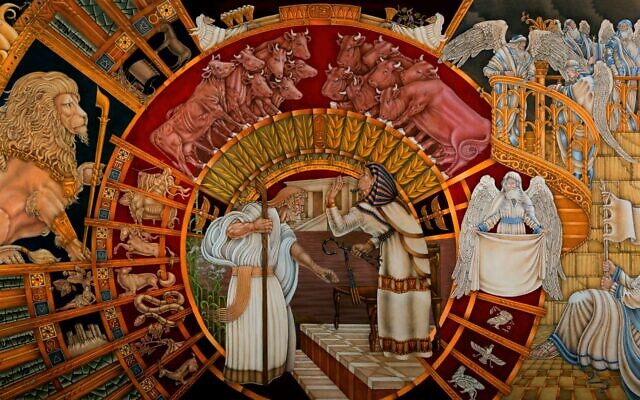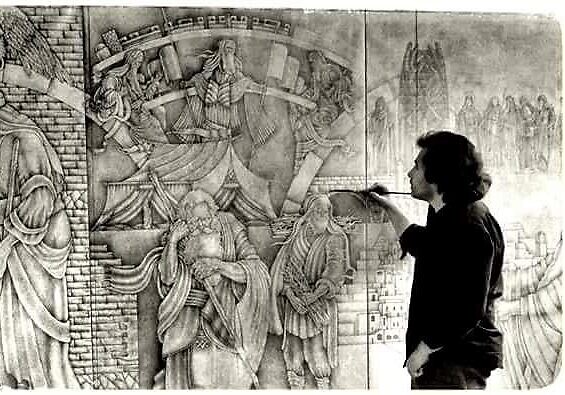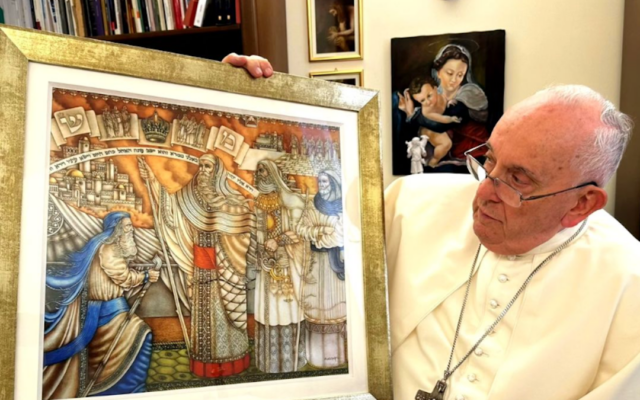Chilean-Jewish Artist Strives to Capture Torah in Massive Murals
Avayu, 55, explained that each book of the Torah takes him about two years to complete. So with four books to go, the project will be complete 8-10 years from now.

(JTA) — As a child, Mauricio Avayu wasn’t allowed to pursue art — his father thought he should study something more practical, like math or engineering. Avayu grew up in the conservative Jewish community of Santiago, Chile, the capital city home to most of the country’s 18,000 Jews.
But by now, Avayu has seen his paintings — many of them Jewish-themed — shown in galleries around the globe, put on the walls in the homes of former presidents around the world and presented to Pope Francis.
Today he’s working on his most ambitious project yet: capturing the key moments of the Torah in 40 large murals.
“Forty is a sacred number in Judaism,” Avayu told the Jewish Telegraphic Agency. “Forty years in the desert, 40 days and nights to receive the Torah.”
He has already finished the eight murals that comprise his depiction of Genesis, the Torah’s first book. The murals, two meters tall, were shipped two years ago to Taipei, where they will be permanently displayed at the Jeffrey D. Schwartz & Na Tang Jewish Taiwan Cultural Association.
Avayu, 55, explained that each book of the Torah takes him about two years to complete. So with four books to go, the project will be complete 8-10 years from now. He already has buyer interest for the entire set.
The majority of Chile’s Jews belong to the Masorti movement, but Avayu didn’t always know that much about Judaism, let alone the Torah. Several years ago he wanted an artistic challenge, and his lack of knowledge intrigued him.

“When I paint now, I always paint with a kippah,” he said. “But even though I come from a home where everyone is Jewish, I didn’t come from a religious family.”
Rather than be intimidated by the vastness of the text, Avayu said he was drawn to its many “hidden messages” and the variety of commentary available for every passage.
And when he looked at past master painters’ depictions of biblical scenes, he was struck by the inaccuracy. For example, in the Sistine Chapel, Michelangelo famously painted God as giving life to Adam by touching his finger. However, the verse in Genesis says God created man through his breath: “And the Lord God formed man of dust from the ground, and He breathed into his nostrils the soul of life, and man became a living soul.”
Driven to be more accurate in his work, Avayu called the leader of Santiago’s Chabad-Lubavitch community and began intensively studying the Torah. He was drawn to Kabbalah too, and studied for about four years at a Kabbalah center in Chile.
“When we think we understand something about a certain passage of the Torah, it’s only at that level,” explained Avayu. “But then suddenly, at a different time, we are able to understand the same passage but at a completely different level.”
To illustrate this point, he gave the example of Moses at Mount Sinai. In Exodus 3:5, God tells Moses to take off his shoes because “the place upon which you stand is holy soil.”
Originally Avayu understood the passage to mean that the taking off of shoes symbolized leaving one’s current path, to pursue the path of God. But upon further study, he believed that taking off the shoes represents Moses leaving the physical body, which was necessary to do as, according to the Torah, Moses fasted for 40 days and nights. So in Avayu’s interpretation of the scene, Moses is barefoot and points towards the sky.
Before he sets out to paint a new work, Avayu not only consults his rabbi but also reads multiple biblical commentaries, from scholars such as Rashi and Maimonides, and chooses the one that resonates most deeply.
When he painted the tree in the Garden of Eden, for example, he consciously did not do what many other famous artists have done: depict the “forbidden fruit” as an apple. Some commentators posit that the fruit is an etrog, others a grape; Avayu prefers the interpretation that it was a fig.
“There’s not only one truth,” he said. “There are a lot of true interpretations.”
Upon seeing Avayu’s art for the first time, Gabriel Goldstein, chief curator at the Yeshiva University Museum, was reminded of the work of Archie Rand — a Jewish artist from Brooklyn who has also painted biblical murals in synagogues across the United States. Goldstein also places Avayu’s artwork in the historic tradition of artists painting “exhaustive series” of the bible.
“There have been for centuries illustrations done for biblical text,” Goldstein told JTA. “Both from very early periods in illumination to much later… in the 19th and 20th centuries.”

When asked if being from Chile has influenced his art, Avayu said that being a Jewish artist who paints Jewish themes from a small country like Chile made his career more difficult, seeing as there isn’t much of a market for his artwork in his native country. But Goldstein found aspects of Avayu’s art that he believes are influenced by his country of origin.
“At the museum, we’ve worked with Latin American artists frequently and have them in our collection,” Goldstein said. “I think that it’s a vibrant community with a vibrant artistic and cultural life. In [Latin American-Jewish art], there is a flavoring that comes from the local culture…as well as from traditional Jewish culture. And I think you can see that in his work — there’s a certain kind of vividness and palette and exuberance that may be more frequently found, but not exclusively found, in Latin American art.”
Since around 2012, Avayu has completed more than 120 paintings and has at least 30 more in the works. Not all of his art involves the Torah: He has also painted ketubahs, Jewish marriage certificates, and he has produced fantastical interpretations of mythological creatures, like the Greek Pegasus. Chilean businessman Tomas Munzer recently gave one of Avayu’s works to Argentina’s ambassador to the Holy See, who presented it to the pope.
In [Latin American-Jewish art], there is a flavoring that comes from the local culture…as well as from traditional Jewish culture. And I think you can see that in his work — there’s a certain kind of vividness and palette and exuberance that may be more frequently found, but not exclusively found, in Latin American art.
Avayu doesn’t have a favorite painting — he calls each his “son” and described the pain he feels when he has to part with one of his children. But now Avayu is creating a different kind of “child,” by opening a studio in Florida where he now teaches aspiring painters. At the Mauricio Avayu Gallery and Fine Art Academy in Aventura, his classes incorporate lessons from the Torah and Kabbalah. And his students — mostly from the United States, but also from Russia, Argentina and Chile — don’t mind the mixing of Judaism and fine art, as almost all of them are Jewish.
“Regardless of my daily goal to be a better artist, to be as perfectionist as possible, I am never satisfied with a painting. I always try to see how I can make it a little better next time. The same always happens with the study of Kabbalah, where you learn something on a related topic, and over time, you realize you’ve learned a deeper level of that same topic,” he said.



comments